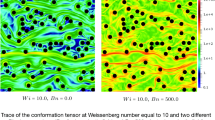Abstract
This paper presents experimental and numerical results of mixed electroosmotic and pressure driven flows in a trapezoidal shaped microchannel. A micro particle image velocimetry (μPIV) technique is utilized to acquire velocity profiles across the microchannel for pressure, electroosmotic and mixed electroosmotic-pressure driven flows. In mixed flow studies, both favorable and adverse pressure gradient cases are considered. Flow results obtained from the μPIV technique are compared with 3D numerical predictions, and an excellent agreement is obtained between them. In the numerical technique, the electric double layer is not resolved to avoid expensive computation, rather a slip velocity is assigned at the channel surface based on the electric field and electroosmotic mobility. This study shows that a trapezoidal microchannel provides a tapered-cosine velocity profile if there is any pressure gradient in the flow direction. This result is significantly different from that observed in rectangular microchannels. Our experimental results verify that velocity distribution in mixed flow can be decomposed into pressure and electroosmotic driven components.








Similar content being viewed by others
References
Bourdon CJ, Olsen MG, Gorby AD (2004) Power-filter technique for modifying depth of correlation in micro-PIV experiments. Exp Fluids 37:263–271
Cui H, Horiuchi K, Dutta P, Ivory CF (2005) Isoelectric focusing in a poly(dimethylsiloxane) microfluidic chip. Anal Chem 77:1303–1309
Cummings EB, Griffiths SK, Nilson RH, Paul PH (2000) Conditions for similitude between the fluid velocity and electric field in electroosmotic flow. Anal Chem 72:2526–2532
Devasenathipathy S, Santiago JG, Takehara K (2002) Particle tracking techniques for electrokinetic microchannel flows. Anal Chem 74:3704–3713
Duffy DC, McDonald C, Schueller OJA, Whitesides GM (1998) Rapid prototyping of microfluidic systems in poly(dimthlsiloxane). Anal Chem 70:4974–4984
Dutta P, Beskok A (2001) Analytical solution of combined electroosmotic/pressure driven flows in two-dimensional straight channels: finite Debye layer effects. Anal Chem 73:1979–1986
Dutta D, Leighton DT (2001) Dispersion reduction in pressure-driven flow through microetched channels. Anal Chem 73:504–513
Dutta P, Beskok A, Warburton TC (2002) Electroosmotic flow control in complex microgeometries. J Microelectromech Syst 11:36–44
Ebadian MA, Dong ZF (1998) Forced convection, internal flow in ducts. In: Rohsenow WM, Harnett JP, Cho YI (eds) Handbook of heat transfer, 3rd edn. McGraw-Hill, New York
Einstein A (1956) Investigations on the theory of the Brownian movement: edited with notes by Fürth R, translated by Cowper AD. Dover, New York
Erickson D, Sinton D, Li DQ (2003) Joule heating and hear transfer in poly(dimethylsiloxane) microfluidic systems. Lab Chip 3:141–149
Friedlander SK (1977) Smoke, dust and haze. Wiley, New York
Hlushkou D, Seidel-Morgenstern A, Tallarek, U (2005) Numerical analysis of electroosmotic flow in dense regular and random arrays of impermeable, non-conducting spheres. Langmuir 21:6097–6112
Keane RD, Adrian RJ, Jensen OS (1995) Super-resolution particle image velocimetry. Meas Sci Technol 6:754–768
Kim MJ, Beskok A, Kihm KD (2002) Electroosmosis-driven micro-channel flows: a comparative study of microscopic particle image velocimetry measurements and numerical simulations. Exp Fluids 33:170–180
Maynes D, Webb AR (2002) Velocity profile characterization in sub-millimeter diameter tubes using molecular tagging velocimetry. Exp Fluids 32:3–15
Meinhart CD, Wereley ST, Santiago JG (1999) PIV measurements of a microchannel flow. Exp Fluids 27:414–419
Meinhart CD, Wereley ST, Santiago JG (2000a) A PIV algolithm for estimating time-averaged velocity fields. J Fluids Eng 122:285–289
Meinhart CD, Wereley ST, Gray MHB (2000b) Volume illumination for two-dimensional particle image velocimetry. Meas Sci Technol 11:809–814
Olsen MG, Adrian RJ (2000) Out-of-focus effects on particle image visibility and correlation in microscopic particle image velocimetry. Exp Fluids 7:S166-S174
Patankar SV (1980) Numerical heat transfer and fluid flow. Hemisphere, New York
Patankar NA, Hu HH (1998) Numerical simulation of electroosmotic flow. Anal Chem 70:1870–1881
Paul PH, Garguilo MG, Rakestraw DJ (1998) Imaging of pressure and electrokinetically driven flows through open capillaries. Anal Chem 70:2459–2467
Probstein RF (1994) Physiochemical hydrodynamics, 2nd edn. Wiley, New York
Santiago JG, Wereley ST, Meinhart CD, Beebe DJ, Adrian RJ (1998) A particle image velocimetry system for microfluidics. Exp Fluids 25:316–319
Sinton D, Erickson D, Li D (2003) Microbubble lensing-induced photobleaching with application to microflow visualization. Exp Fluids 35:178–187
Takehara K, Adrian RJ, Etoh GT, Christensen KT (2000) A Kalman tracker for super-resolution PIV. Exp Fluids 29:SO34-SO41
Tieu AK, Mackenzie MR, Li EB (1995) Measurements in microscopic flow with a solid-state LDA. Exp Fluids 19:293–294
Wereley ST, Gui L, Meinhart CD (2002) Advanced algorithms for microscale particle image velocimetry. AIAA Stud J 40:1047–1055
Xia Y, Whitesides GM (1998) Soft lithograogy. Angew Chem Int Ed Engl 37:550–575
Yang C, Li D (1998) Analysis of electrokinetic flow on the liquid flows in rectangular microchannels. J Colloids Surf 143:339–353
Acknowledgments
The authors thank Mr. Henry Ruff and Mr. Mark Fuller for their valuable suggestions on fabrication techniques. This investigation was supported in part by the Washington State University Office of Research, and in part by the National Science Foundation under Grant No. CTS0300802.
Author information
Authors and Affiliations
Corresponding author
Rights and permissions
About this article
Cite this article
Horiuchi, K., Dutta, P. & Richards, C.D. Experiment and simulation of mixed flows in a trapezoidal microchannel. Microfluid Nanofluid 3, 347–358 (2007). https://doi.org/10.1007/s10404-006-0129-0
Received:
Accepted:
Published:
Issue Date:
DOI: https://doi.org/10.1007/s10404-006-0129-0




